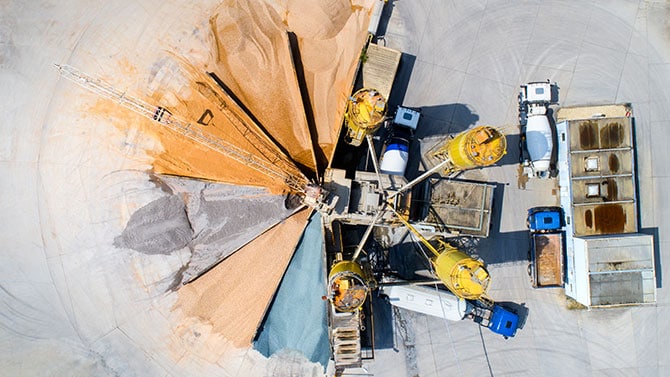{{item.title}}
{{item.text}}

{{item.text}}
Normality has been gradually returning to the Swiss economy since the beginning of the year. The recovery continues but is losing momentum as the year draws to a close on account of capacity constraints and ongoing Corona restrictions. The construction index is benefiting from catch-up effects following the pandemic but is being held back by shortages of materials. The SNB continues to pursue its expansionary monetary policy. Demand for owner-occupied property and real estate investments remains high, leading to another price increase in the housing sector. The commercial real estate market is experiencing reduced returns and consequently valuation declines, although the trends differ across the regions.
Real gross domestic product in Switzerland continues to recover and, at 110.6 index points (1991: 100), has now surpassed its pre-crisis level recorded at the end of 2019.1,2 However, the recovery is losing momentum and is less vigorous than expected. This trend is explained by bottlenecks in primary products and in transport capacities and by ongoing coronavirus measures in the service sector.2 The capacity bottlenecks are not expected to ease up until the start of 2022.3 Despite the slowdown, economic growth nonetheless points to an above-average expansion in activity and a sustained recovery.4 The forecasts for expected GDP for 2021 are lower than in the previous quarter at 3.2% (July 2021 3.6%) [8]. GDP expectations for 2022, at 3.4%, are more optimistic than current expectations for 2021 and remain above the potential growth rate of 1.5% [9].
The effect of the economic recovery is clearly reflected in the labour market. Short-time work due to the pandemic is expected to fall sharply. In July 2021 58.2% fewer people were affected by short-time work.5 Unemployment is expected to decline further in the coming quarter. An average unemployment rate of 3.1% is forecast for 2021 (July 2021 3.2%). The expected rate for 2022 has fallen to 2.6% (July 2021 2.8%) [8]. The number of job vacancies is rising steadily, with the largest increase to be found in the financial and insurance service sector at 31.2% compared to the second quarter. The mechanical engineering sector has the largest number of jobs on offer [10]. The increase in job numbers will serve to close the remaining production gaps, given that production capacity has contracted by 1.3% this year.3
The SNB continues to counter the remaining effects of the pandemic by means of an expansionary monetary policy. The reference rate remains unchanged at –0.75%. At the same time, the SNB is reserving the option of investing against the strong franc via the currency market, if necessary.[1] The inflation forecast for 2021 has once again increased slightly against the previous quarter. The SNB is expecting an inflation rate of 0.5% for 2021 (previous quarter 0.4%). For 2022 it anticipates a rate of 0.7% (previous quarter 0.6%). The forecast for 2023 remains unchanged at 0.6% [11]. As in the previous quarter, the prospect of rising inflation is based on increased prices for crude oil products and the pandemic-related supply bottlenecks resulting in rising prices for raw materials. However, the national consumer price index has remained stable at 101.3 points because of countervailing effects in consumer goods prices. The rise in inflation recorded in the second quarter was a short-term fluctuation, which has now normalised again as a result of price reductions in certain sectors following steps to re-open the economy. 1
The mood regarding yields on government bonds was likewise more optimistic in the second quarter than in the third. In the third quarter, yields on one, five and ten-year Swiss government bonds were corrected downwards again. Thus, yields on these bonds in October 2021 were –0.78%, –0.62% and –0.31% (June –0.76%, –0.5% and –0.16%) [22]. According to forecasts from SECO, KOF and Créa, the steady yields on ten-year government bonds are forecast to average –0.33% in 2021 and –0.3% in 2022[20]. Interest rates on three, five and ten-year fixed-rate mortgages have fallen in comparison with March, and in August were 1.03%, 1.09% and 1.37% (June 1.04%, 1.09%, 1.35%) [23]. As long as inflation is projected to remain below the 1% mark, the negative interest rate environment is likely to persist. The interest rates for SARON mortgages will also languish at a very low level in the coming 12 months. However, a slight increase in interest rates can be expected for fixed-rate mortgages.7
The recovery trajectory of the construction index continued in the third quarter of 2021. The increase in revenues (adjusted for seasonal and calendar effects) exceeded the figures for the previous quarter by around 1.7%. Housing construction (+8.4%) and commercial construction (+6%) in particular recorded the highest growth rates, reflecting catch-up effects. The construction index (2015: 100) stood at 145 points and showed an increase of 2.11% against the previous quarter, while the improvement year on year was 5.7% [17]. The biggest risk factor for progress in construction work remains the shortages of essential building materials, which have already led to price rises in the construction sector. 8 Compared to the previous half-year, the construction price index has risen by 1.1% [19]. The production cost index for stone and concrete construction is around 3.3% higher than in the previous quarter. Meanwhile, building and industrial construction shows a year-on-year increase of 14.1% [18].
The third quarter forecasts for construction activity were all in positive territory, at 0.4% for 2021, 0.6% for 2022 and 0.5% for 2023. Although building activity was expected to be weaker in the long term compared with the previous quarter, a swifter recovery is anticipated [16]. According to the analysis of planning applications, around 24% fewer applications for office premises were registered in the first half of 2021 compared to the same period last year. New construction is concentrated in parts of the northwestern Mittelland region, in the canton Schaffhausen, in the canton Thurgau, in the Lake Zurich region and in some regions in central Switzerland and Ticino.8
The economic situation continues to promote a preference for owner-occupied housing. Expansionary monetary policy, the price attractiveness of home ownership compared to renting, a shortage of real estate supply and an increased awareness of one's own housing situation as a result of the pandemic are leading to a growing demand for owner-occupied housing.9 Further price increases are expected in the second half of 2021 as a result of the relaxed economic situation and purchasing power that has returned to pre-crisis levels.10
The upward spiral was evident in the third quarter, with residential properties rising 1.3% against the previous quarter and 6.7% against the same quarter last year, although the increase was less steep than in the earlier quarters of 2021 (first quarter +2.11%, second quarter +1.3%). In historical terms, the prices for residential property rose by 6.4% overall between 2015 and 2020 (single-family homes 6.1%, owner-occupied apartments 6.9%) and, at 248.1 index points (1985: 100), are at an all-time high. In the third quarter of 2021 single-family homes recorded a relative price rise of 1.5% against the previous quarter and 7.2% year-on-year. For owner-occupied apartments, a moderate increase of 0.9% against the previous quarter and 5.9% against the same quarter last year were recorded.11 In a regional comparison, prices for owner-occupied apartments grew compared to the previous quarter in the Geneva (+2.3%) and Mittelland (+1%) regions. Last year, however, owner-occupied apartment prices rose in all regions, and particularly in southern Switzerland (+5.9%) and the Alpine region (+7.8%). Prices for single-family homes rose by 7.0% nationally last year. The largest appreciation in value was recorded in the Jura (+10.2%) and Zurich (+9,7%) regions, with the high-price properties in the premium segment rising the most last year (owner-occupied apartments +7.6%, single-family homes +10.7%). Compared to the previous quarter, the largest appreciation in value was registered in the mid-price segment (owner-occupied apartments +0.9%, single-family homes +2.2%).11
The pandemic put a brake on the construction of new housing in the rental market. Restrictive measures combined with supply shortages of building materials led in part to delays on building sites.7 The volume of new building permits for rental apartments rose by 7.2% between the second quarter of 2020 and the second quarter of 2021, which means the stock of newly constructed apartments is likely to increase again in the medium term.10 In the same period, the vacancy rate fell for the first time since 2009. With a drop of around 15% (vacancy rate for Switzerland in 2021 1.54%), this would seem to indicate a turnaround. The reasons for this shift are efforts by policymakers to tackle the issue of vacant properties, the adjustment in residential preferences brought about by the pandemic and extensive home working arrangements.12 Net yields remained stable in the third quarter, both against the previous quarter and year-on-year.13 While real estate investments continue to offer attractive and stable returns compared to government bonds, the real estate market remains tight for buyers. The pressure on total returns in particular intensified in 2021. Total returns on multi-family units nationally were 3.4% in June 2021 (2020 4.8%).13 The minimum discount rate for multi-family units at prime locations was 1.79% in October, which means it had contracted by a further 2 basis points compared to the analysis in August 2021 [34]. Discount rates on multi-family units (in real terms, net) are falling [35]. With growth in market values across Switzerland, the Basel (+1.7%) and Geneva (+1.3%) regions recorded the strongest market gains in the quarterly comparison. Year on year, the southern Switzerland region (–1.7%) and Alpine region (–1.8%) registered the largest losses in market value.13
In September 2021 Switzerland recorded a higher net immigration compared to 2019 and 2020, and should therefore be seen as a supporting increased housing demand. [12, 13]. However, during the pandemic the housing situation was reassessed in many places, which also affected rents for housing, particularly in urban regions. In contrast to the previous three quarters, rents for new-build housing in the third quarter were on a downward trend at –0.7% (existing properties –0.3%). A 0.5% drop in rents can be seen across existing and new-build properties taken together. In regional terms, market rents dropped against the previous quarter for both existing and new-build housing in all regions except the Jura region (+1.6%) and the Alpine region (+0.2%) [25, 26].14
Despite the hesitant return to office life, lower use of offices can be expected to continue in the third quarter (most recently 12% below the pre-pandemic level). This lower office use is also reflected in planning applications, which are 19% below their long-term average. The trend towards reduced construction activity is a reaction to the long-term reduced demand forecasts for the office space, which will kick in with a time lag. Once regular rental contract terms come to an end, increased vacancy rates and falling rents can be expected.7
In terms of transaction prices, a slight reduction in market rents can be inferred in the third quarter [2, 36]. Transaction prices for office space fell in all regions compared with the second quarter (Basel –5.1%, Mittelland –2.9%, Zurich –2.4%, Lake Geneva –1.4%). Year on year there was a drop in the Mittelland (–1.8%) and Lake Geneva (–0.8%) regions, while the Basel and Zurich regions continued to record significant rent increases at 3.1% and 3.6% [37, 38]. A steady rise in rents was recorded in cantons Freiburg (third quarter +5.7%, year on year +16.3%), Schaffhausen (third quarter +5.3%, year on year +10.8%) and Zug (third quarter +5%, year on year +24.8%). The rent increases have resulted in significant gains in market value year on year, of up to 13% in canton Freiburg, 9.8% in canton Schaffhausen and 30.7% in canton Zug. The largest losses in value against the same quarter last year were recorded in cantons Lucerne (–11.4%) and Geneva (–7.4%) [40].13
In September 2021 retail sales rose by 1.9% in nominal terms compared to the same month last year, though showing no change from the previous month.15 Sales performance was split at segment level, with the already sluggish non-food sector more affected by the pandemic than the food sector. The clothing market in particular has had to deal with a significant contraction in revenues (April 2020 19 index points, January 2021 20 index points (2018: 100)). By contrast, the food segment and electrical products have experienced a boom (fourth quarter of 2020 145 and 180 index points respectively). Restrictions and shop closures have accentuated the trend towards online shopping. In the fourth quarter of 2020 retail space recorded the highest vacancy rates since the first quarter of 2018 at almost 6%. Since then, the trend has been downwards with a vacancy rate in July 2021 of around 5.5%. However, in peripheral areas further difficulties can be expected in the market for retail space in the medium to long term.9
As expected, the hospitality sector is still suffering the most as a result of the pandemic and has recorded negative employment growth of –0.5%.9 The ongoing support measures are keeping the sector afloat. The movement in real estate prices remains subject to risk following the state assistance measures. Restaurant tenants have so far acted as an anchor for empty retail space and have made up for the vacancies in retail space by converting it to other uses. The weakened restaurants sector means that marketing difficulties can be expected to increase even after the pandemic, particularly in peripheral locations.9
1 Swiss Life Asset Managers, Perspectives: Economics, October 2021
2 Swiss State Secretariat for Economic Affairs (SECO), press release of 16 September 2021: Economic forecast
3 ETH Zurich, Konjunkturanalyse: Prognose 2022/2023: Erholung der Schweizer Wirtschaft setzt sich fort, Risiken werden vielfältiger
4 KOF, economic barometer: recovery continues
5 State Secretariat for Economic Affairs (SECO), Die Lage auf dem Arbeitsmarkt im September 2021
6 Swiss National Bank (SNB), Quarterly Bulletin 3, September 2021
7 Credit Suisse, Real Estate Monitor Switzerland September 2021: Trend reversal on housing market
8 Credit Suisse, Swiss Construction Index Q3 2021
9 Raiffeisen, Immobilien Schweiz Q3 2021
10 Wüest Partner, Immobilienmarkt Schweiz 2021/3
11 FPRE, transaction price and building plot indices for owner-occupied property, Q3 2021
12 Zürcher Kantonalbank (ZKB), Immobilienbarometer, Q3 2021
13 FPRE, market indices for investment properties, data as at 6 August 2021
14 FPRE, transaction price and building plot indices for investment properties, data as at 6 August 2021
15 Swiss Federal Statistical Office (FSO), press release of 2 November 2021: Swiss retail trade turnover rose in September
{{item.text}}

{{item.text}}

Sebastian Zollinger
Director, Head Real Estate Advisory, PwC Switzerland
Tel: +41 58 792 28 87



